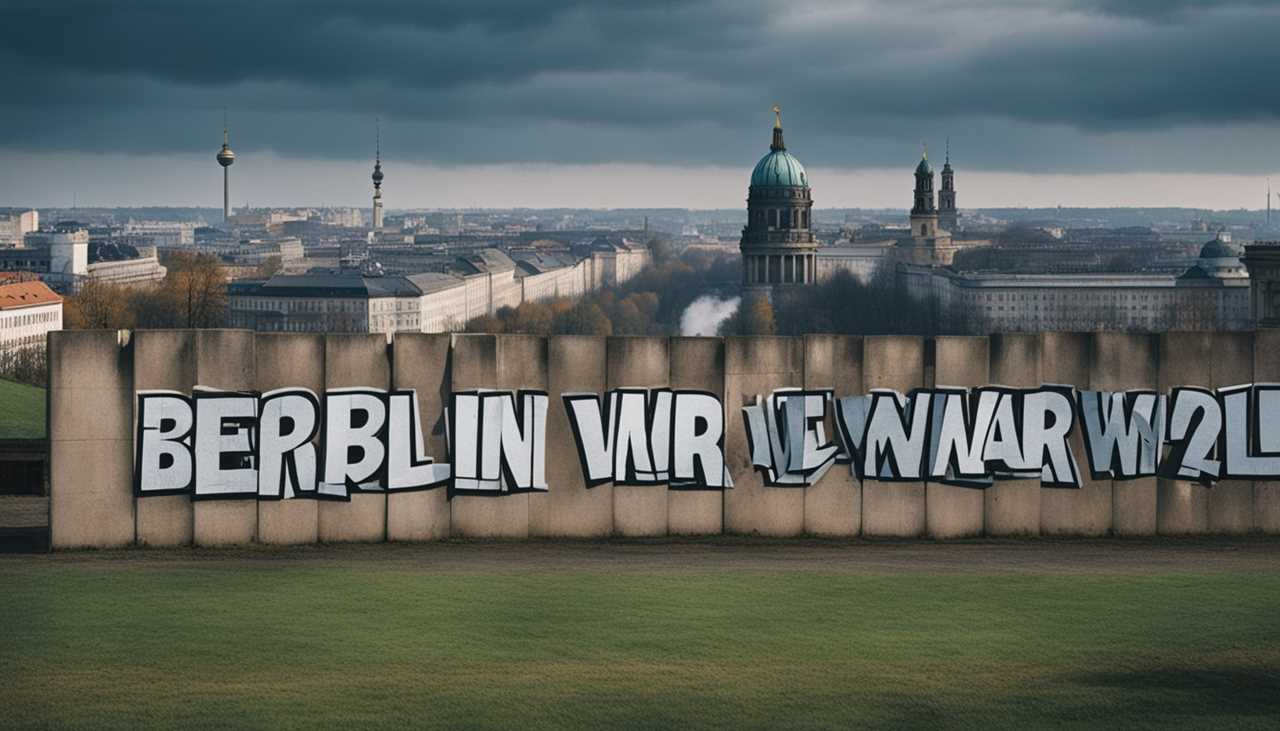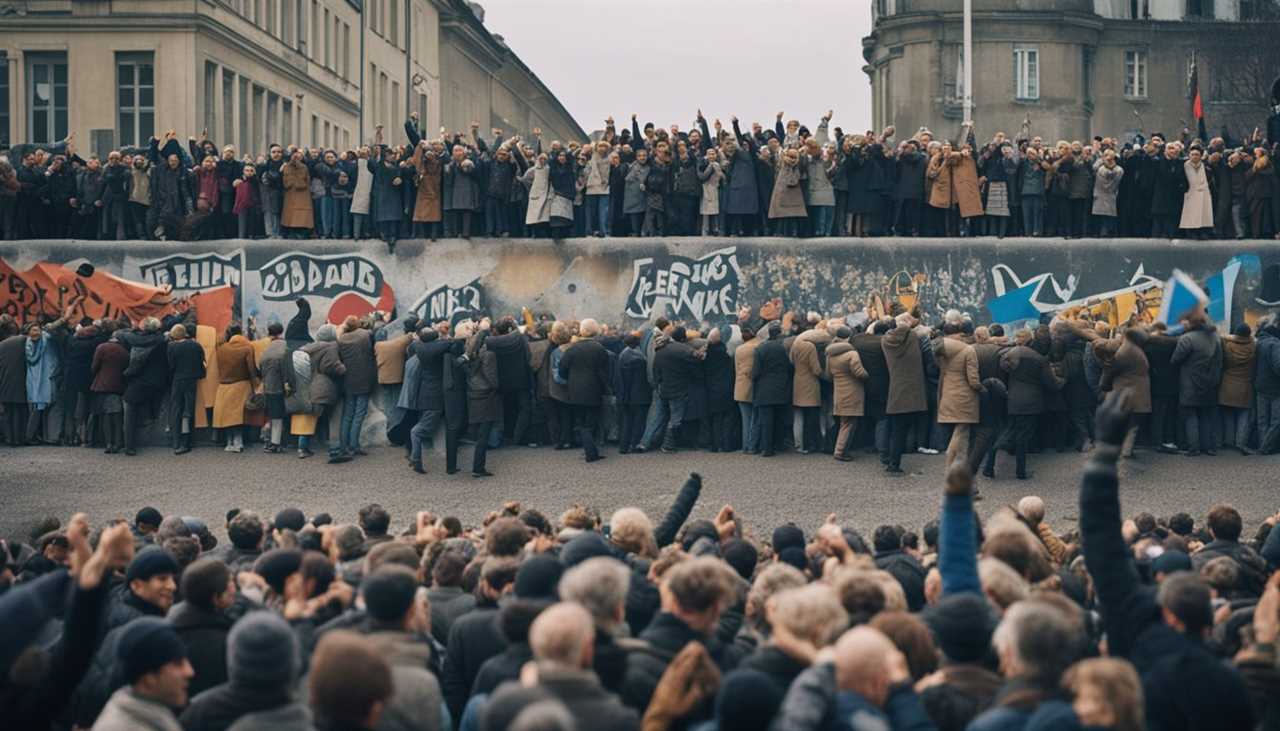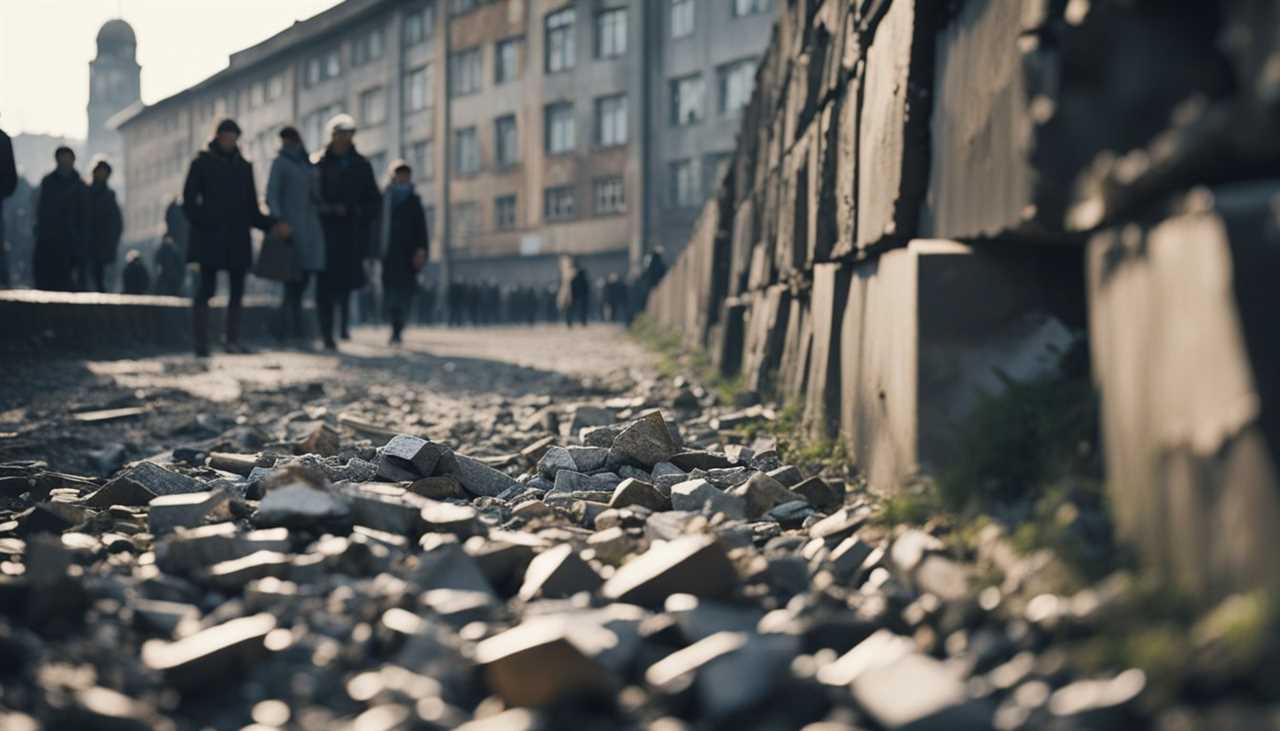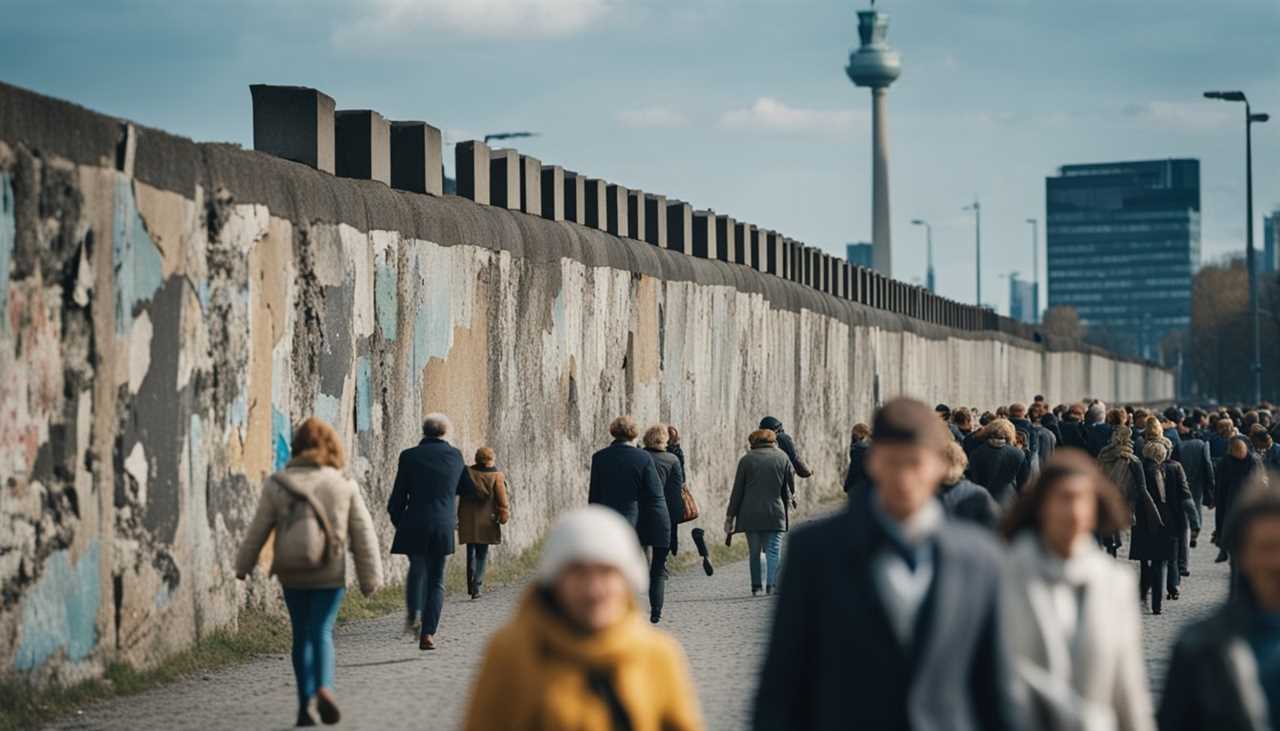The Cold War was when there was a lot of political stress between two groups - the Western Bloc, with the United States in charge, and the Eastern Bloc, with the Soviet Union leading. After the Cold War, big changes happened that showed it was ending. These included changes within the Soviet Union, the destruction of the Berlin Wall, and the start of new policies that broke apart the strong unity of communist countries.

These transformative moments not only signaled the political and ideological shift that was taking place globally but also set the stage for a new world order. The leadership of Mikhail Gorbachev played a pivotal role in policies like Perestroika and Glasnost, which aimed at reforming the Soviet political and economic system.
In parallel, the physical and symbolic collapse of the Berlin Wall in 1989 became a central emblem for the end of the Cold War. This was followed by the official dissolution of the Soviet Union in 1991, which led to the emergence of new independent republics.
Key Takeaways
- The Cold War ended with a series of events that included political reforms and the dissolution of the Soviet Union.
- The fall of the Berlin Wall and Germany's reunification were symbolic and practical markers of the Cold War's end.
- The aftermath altered global dynamics, leading to new geopolitical challenges and legacies.
Historical Context
The end of the Cold War was a pivotal moment in history, shaped by the tensions that escalated after World War II and the division of global powers into opposing factions.
Post-World War II Tensions
Following World War II, two superpowers emerged: the United States and the Soviet Union. These nations and their respective allies were divided by the Iron Curtain, a metaphorical split that represented the ideological conflict and physical boundary dividing Europe.
The Eastern Bloc, the group of satellite states under the influence of the Soviet Union, was established during this period. Notably, at the Potsdam Conference of 1945, leaders, including Soviet leader Joseph Stalin, set the terms for post-war recovery, furthering the divide between the Allied Powers and the Soviet Union.
Formation of NATO and the Warsaw Pact
In response to growing Soviet influence, the Western Allies formed the North Atlantic Treaty Organization (NATO) in 1949, aiming to secure collective defense against the Eastern Bloc. The United States also initiated the Marshall Plan to aid Western European economies and prevent the spread of Soviet communism.
In retaliation, the Warsaw Pact was signed in 1955, solidifying a collective defense arrangement among the Soviet Union and its satellite states. These alliances and actions set the stage for the decades-long standoff known as the Cold War.
Key Cold War Events

The Cold War was punctuated by several critical incidents showcasing deep-seated rivalries and high-stakes tension between the Soviet Union and the Western powers, particularly the United States. These events were pivotal in foreign policy and international relations during the era.
Berlin Airlift
In 1948, the Berlin Airlift became a symbol of the Allied powers' commitment to supporting West Berlin amidst a blockade by the Soviet Union. Faced with the challenge of maintaining a lifeline to the city, supplies were flown in around the clock, highlighting the conflict between communist regimes and the desire to uphold Western democracy in a divided Berlin.
Cuban Missile Crisis
The Cuban Missile Crisis in 1962 marked a peak in Cold War tensions. The United States and the Soviet Union stood on the brink of nuclear war after American reconnaissance revealed Soviet missiles in Cuba. Following intense negotiations, the crisis was diffused, reflecting the delicate balance of power and the constant negotiation inherent in the foreign policy of the era.
Checkpoint Charlie Standoff
The Checkpoint Charlie Standoff of 1961 epitomized the division of Berlin and heightened tensions between the East German government and the Western powers. U.S. and Soviet tanks faced off at the checkpoint following a dispute over the U.S. diplomat's access to East Berlin, turning it into a symbol of the Cold War's potential for sudden escalation.
Each of these events played a significant role in shaping the latter half of the 20th century, characterizing the persistent struggle between different governance ideologies and the precarious nature of global peace during the Cold War period.
Rise of Gorbachev
Mikhail Gorbachev's ascent to power as the leader of the Soviet Union marked a pivotal turning point in the Cold War era. His innovative policies and diplomatic approach dramatically shifted the ideological and political landscape not only within the Soviet Union but also across the Eastern Bloc and the wider international stage.
Perestroika and Glasnost
Gorbachev introduced Perestroika (restructuring) and Glasnost (openness) as radical reforms to revitalize the Soviet Union's stagnating economy and grant its citizens more freedom.
Perestroika aimed to transition from a strict centralized economy to one that embraced limited market mechanisms, including the allowance of private businesses and foreign investment. In contrast, Glasnost sought to foster a more transparent and open governmental environment, promoting freedom of information and easing the strict controls over the press.
Reform Policies
Under Gorbachev's leadership, reform policies extended into foreign relations, fundamentally altering the Soviet Union's approach to the Eastern Bloc and international diplomacy.
Gorbachev's foreign policy was characterized by a willingness to engage in dialogue, reduce nuclear arsenals, and allow greater autonomy in Eastern Bloc countries. These reforms culminated in the:
- Reduction of Soviet military presence
- Signing of historic disarmament treaties with the West
- Revocation of the Brezhnev Doctrine, which had previously justified Soviet intervention in Eastern Bloc nations to maintain communist rule.
These sweeping changes catalyzed the loosening of the Soviet grip on Eastern Europe and laid the groundwork for ending the decades-long Cold War.
The Fall of the Berlin Wall

The demise of the Berlin Wall on November 9, 1989, stands as a pivotal milestone in world history, symbolizing the end of the Cold War and paving the way for Germany's reunification.
Peaceful Protests
In the late 1980s, the German Democratic Republic (GDR) experienced a surge of peaceful protests. Citizens, yearning for political reform and emigration rights, initiated demonstrations. This civil unrest signaled a weakening of the East German regime's grip on power and was integral to the events leading to the fall of the Berlin Wall.
Opening of the Berlin Wall
The opening of the Berlin Wall was prompted by the cumulative pressure of the protests and miscommunication by the East German government's spokesperson.
On the night of November 9, 1989, the announcement that East Germans could cross into West Berlin led to jubilant crowds gathering at the wall, culminating in its breach. The event effectively marked the collapse of the East German regime and became a symbol of the impending reunification of Germany. Mr. Gorbachev's policies of glasnost and perestroika had already set the stage for change, which the East Germans seized, ending decades of division.
Collapse of the Soviet Union

The end of the Cold War is often attributed to the collapse of the Soviet Union, a historic dissolution marked by a series of transformative events. In August 1991, a coup attempt by hard-line communists, known as the Gang of Eight, against Soviet President Mikhail Gorbachev sent shockwaves through the international community but ultimately failed, exhibiting the weakening grasp of Soviet authority.
In the backdrop of these dramatic events, the reformation policies of glasnost (openness) and perestroika (restructuring), initiated by Gorbachev, catalyzed socio-political change.
These policies encouraged open discourse and democratic tendencies within the Soviet republics, which hastened the unraveling of the Soviet political fabric.
The fall of the Berlin Wall in November 1989 symbolized not only the physical but also the ideological collapse of barriers separating Communist East Germany from the West. The reunification of Germany in 1990 further signified diminishing Soviet influence in Central and Eastern Europe.
By December 1991, the Soviet Union ceased to exist, splintering into fifteen independent republics. The Cold War landscape was fundamentally altered as the bipolar world order introduced new geopolitical dynamics.
- Key Dates:
- August 1991: Coup attempt against Gorbachev
- November 1989: Fall of the Berlin Wall
- December 1991: Official dissolution of the Soviet Union
Mikhail Gorbachev, a pivotal figure in the Cold War's conclusion, stepped down on December 25th, 1991, providing a clear end to the era of communist dominance in Eastern Europe. This event concluded a tumultuous chapter in global history.
Germany's Road to Reunification

Germany's journey toward reunification was a transformative period marked by escalating economic and political pressures, which led to the formal merger of the German Democratic Republic (East Germany) and the Federal Republic of Germany (West Germany).
Economic and Political Pressures
Significant economic struggles and calls for political reform within the German Democratic Republic characterized the late 1980s. East Germany's economy was faltering badly compared to the more prosperous West Germany, leading to widespread dissatisfaction and unrest among its citizens. This economic disparity was compounded by the restrictive nature of East Germany's political system, which began to face increasing pressure for liberalization. Public demonstrations amplified as East Germans demanded reforms, swayed by the policies of glasnost and perestroika in the Soviet Union.

Formal Reunification
The reunification process took a definitive turn on November 9, 1989, when the Berlin Wall came down. This signaled the collapse of the East German government's hold over its people.
The following year was punctuated by negotiations and legislative movements. These would culminate in the official reunification of Germany.
On October 3, 1990, the two Germanys were united after the Unification Treaty. This marked the end of separate East and West German states.
The former East German territories were integrated into the Federal Republic of Germany. This led to significant social, economic, and political challenges that the new Germany would spend the ensuing years navigating.
Aftermath and Legacies
The culmination of the Cold War fundamentally redefined global dynamics and the political landscape of former communist states.
Changes in International Relations
With the cessation of the East-West standoff, countries worldwide witnessed a significant shift in diplomatic strategies and defense policies.
The end of bipolarity gave rise to newer, more complex forms of international engagements.
The Western allies, particularly the United States and members of NATO, sought to expand their influence and promote democracy in the regions once dominated by Soviet power.
Former adversaries engaged in dialogue. They fostered cooperation through numerous treaties and agreements. Establishing partnerships through economic, cultural, and defense alliances became essential in an increasingly interconnected world.
Effects on Former Communist States
The dissolution of the Soviet Union and the collapse of communist regimes across the Eastern Bloc unleashed a wave of transformations.
Political systems and governance in these states underwent radical change. This often replaced one-party rule with multi-party systems and democratic elections.
Economically, former communist states grappled with transitioning from planned economies to market-based systems.
The process was complex and varied by country, resulting in different degrees of success and challenges. These included the privatization of state-owned enterprises, the introduction of competitive markets, and integration into global trade systems.
These changes set a foundation for future growth. However, they also exposed these nations to new vulnerabilities, including economic inequalities and the destabilizing effects of rapid privatization.
Frequently Asked Questions
These frequently asked questions address pivotal aspects of the Cold War's end. They highlight the multifaceted processes that led to this significant period in history.
What were the defining events that led to the conclusion of the Cold War?
The conclusion of the Cold War was marked by several critical events, including the fall of the Berlin Wall, the subsequent reunification of Germany, and the dissolution of the Soviet Union. These events signaled the breakdown of the decades-long geopolitical and ideological struggle.
Which international treaties or agreements contributed to the closure of the Cold War era?
International treaties such as the Intermediate-Range Nuclear Forces (INF) Treaty of 1987 played a significant role. This treaty, among others, led to a de-escalation of nuclear tension between the United States and the Soviet Union, thereby contributing to the end of the Cold War.
How did the Soviet Union's dissolution influence the end of the Cold War?
The dissolution of the Soviet Union was a decisive factor in ending the Cold War. It led to the emergence of several independent countries from the former Soviet bloc, which shifted the balance of power and ended the East-West divide that had characterized the period.
What role did global leaders play in bringing about the end of the Cold War?
Leaders such as Mikhail Gorbachev, Ronald Reagan, and Margaret Thatcher were instrumental in the Cold War's conclusion. Gorbachev's policies of glasnost and perestroika, combined with Reagan's diplomatic pressure, helped to facilitate a climate of détente.
Can the end of the Cold War be attributed to a single event or was it a gradual process?
The end of the Cold War cannot be attributed to a single event; it was the result of a gradual process. A series of events and reforms cumulatively led to the decline and eventual fall of long-standing Cold War tensions.
What were the global political consequences that followed the termination of the Cold War?
Following the Cold War, the world saw a shift in global politics:
The rise of the United States as the sole superpower, the expansion of NATO, and a new era of international relations that was no longer defined by the bipolar confrontation of two superstates.






